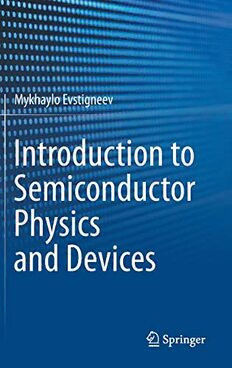
Introduction to Semiconductor Physics and Devices PDF
Preview Introduction to Semiconductor Physics and Devices
Mykhaylo Evstigneev Introduction to Semiconductor Physics and Devices Introduction to Semiconductor Physics and Devices Mykhaylo Evstigneev Introduction to Semiconductor Physics and Devices MykhayloEvstigneev DepartmentofPhysicsandPhysical Oceanography MemorialUniversityofNewfoundland St.John’s,NL,Canada ISBN978-3-031-08457-7 ISBN978-3-031-08458-4 (eBook) https://doi.org/10.1007/978-3-031-08458-4 ©TheEditor(s)(ifapplicable)andTheAuthor(s),underexclusivelicensetoSpringerNatureSwitzerland AG2022 Thisworkissubjecttocopyright.AllrightsaresolelyandexclusivelylicensedbythePublisher,whether thewholeorpartofthematerialisconcerned,specificallytherightsoftranslation,reprinting,reuse ofillustrations,recitation,broadcasting,reproductiononmicrofilmsorinanyotherphysicalway,and transmissionorinformationstorageandretrieval,electronicadaptation,computersoftware,orbysimilar ordissimilarmethodologynowknownorhereafterdeveloped. Theuseofgeneraldescriptivenames,registerednames,trademarks,servicemarks,etc.inthispublication doesnotimply,evenintheabsenceofaspecificstatement,thatsuchnamesareexemptfromtherelevant protectivelawsandregulationsandthereforefreeforgeneraluse. Thepublisher,theauthorsandtheeditorsaresafetoassumethattheadviceandinformationinthisbook arebelievedtobetrueandaccurateatthedateofpublication.Neitherthepublishernortheauthorsor theeditorsgiveawarranty,expressedorimplied,withrespecttothematerialcontainedhereinorforany errorsoromissionsthatmayhavebeenmade.Thepublisherremainsneutralwithregardtojurisdictional claimsinpublishedmapsandinstitutionalaffiliations. ThisSpringerimprintispublishedbytheregisteredcompanySpringerNatureSwitzerlandAG Theregisteredcompanyaddressis:Gewerbestrasse11,6330Cham,Switzerland Preface When I was assigned to teach physics of device materials at Memorial University of Newfoundland 7 years ago, I got excited. Who would not be happy to tell the studentsaboutsuchdiverseareasasquantummechanics,statisticalphysics,theory ofsolids,electrodynamics,andcrystallography,nottomentionsomecoolelectronic applications, in a one-semester course? This opportunity was especially thrilling, becausethemajorityofmyaudienceconsistedofsecond-yearengineeringstudents withlittleornopriorknowledgeaboutmostofthesesubjects.Itisalwaysgreatto bethefirsttotellyoungpeopleaboutsomethingtremendouslyimportant. Finding a suitable text is the first challenge an instructor faces before teaching a course. This choice is usually made based on two factors: the knowledge the instructorintendstoimparttothestudentsandtheirbackgroundpreparationlevel. There are many excellent books on semiconductor physics. But some of them implicitly assume the readers’ familiarity with the topics mentioned above, while others dig into those topics too deeply and are more suitable for the advanced undergraduate or graduate physics students. Neither description applied to my audience. Hence, I wrote a few pages on quantum mechanics and a few on statistical physics,whichIsharedwiththestudentsasahandout.AsIwasteachingthiscourse inthefollowingyears,Iaddedmorematerialtothosenotes,whichfinallydeveloped intothisbook. The book contains three roughly equal parts, each of which can be covered in aboutonemonth’stime.Thefirstpart,FundamentalPhysics,givesthebackground informationstudentswillneedtounderstandtherestofthetext:quantummechan- ics, crystal structure of solids, statistical mechanics, and band theory of solids. In the second part, this information is applied to explain the basic properties of semiconductors, namely the concentration of charge carriers in equilibrium, the interrelationbetweenthecarrierconcentrationandanon-uniformelectricpotential, the generation-recombination processes, and, finally, the response of the charge carriers to an electric field. The third part applies what the students have learned v vi Preface earlierinthebooktoexplainsomesemiconductordevices:theSchottkydiodes,the MOSFETs,thepnjunctiondiodes,andsomeoptoelectronicapplicationsthereof. Sincemyintentionwastogiveonlyslightlymorematerialthancanbedelivered within a one-semester course, many topics were left out. For example, the size- related effects in the semiconductor devices and the bipolar transistor are not discussed.Aninterestedreaderisreferredtoanumberofexcellenttextstofillthose gaps,suchas: K.Brennan,ThePhysicsofSemiconductors(CambridgeUniversityPress,1999) J.P. Collinge and C.A. Collinge, Physics of Semiconductor Devices (Kluwer AcademicPublishers,2002) J.A. del Alamo, Integrated Microelectronic Devices: Physics and Modeling (Pearson,2018) C.Hamaguchi,BasicSemiconductorPhysics(Springer,2010) C.Hu,ModernSemiconductorDevicesforIntegratedCircuits(Pearson,2009) M.Grundmann,ThePhysicsofSemiconductors(Springer,2010) J.P.McKelvey,SolidStateandSemiconductorPhysics(R.F.KriegerPublishing Company,1966) R.S. Muller and Th.I. Kamins, “Device Electronics for Integrated Circuits” (Wiley,2002) D.Neamen,SemiconductorPhysicsandDevices(McGraw-Hill,2003) C.Papadopoulos,Solid-StateElectronicDevices(Springer,2014) R.F. Pieret, Semiconductor Device Fundamentals (Addison-Wesley Publishing Company,1996) D.K. Schroder, Semiconductor Material and Device Characterization (Wiley, 2006) K.Seeger,SemiconductorPhysics(Springer,2004) R.A.Smith,Semiconductors(CambridgeUniv.Press,1978) S.M.SzeandM.K.Lee,SemiconductorDevices(Wiley,2012) S.M.SzeandK.K.Ng,PhysicsofSemiconductorDevices(Wiley,2007) P.Y.YuandM.Cardona,FundamentlalsofSemiconductors(Springer,2010) Reading a book like this is best done with pencil and paper. Ideally, a student should understand the material well enough to be able to explain it to another student. At the end of each chapter, the student will find problems that should, hopefully, strengthen their understanding of the chapter material. Each of the problem sections consists of three parts: solved problems, practice problems, and solutions.Studentsareencouragedtofirsttryandtackletheproblemsbythemselves andlookintothesolutionsonlyiftheyarestuck. AlthoughImadeeveryefforttomakethisbookfreeoferrors,Icannotguarantee that it is. I will greatly appreciate it if the readers inform me about any typo and mistake they find, or offer any other suggestions and criticism by email at [email protected]. Iwouldliketothankmystudentsandcolleaguesfortheirinput.Iamindebtedto Dr. Michael Morrow for sharing his own materials with me when I got to teach this course for the first time. It has been a great pleasure to discuss pertinent Preface vii subjects with Drs. Anatoliy Sachenko and Igor Sokolovskyi from the Institute of SemiconductorPhysicsinKyiv,Ukraine.Lastbutnotleast,IthankGlebEvstigneev forhissuggestionsthathelpedmeimprovethestyleofthistext. IdedicatethisbooktoUkraine,mybravehomecountry. St.John’s,NL,Canada MykhayloEvstigneev Contents PartI FundamentalPhysics 1 PrinciplesofQuantumMechanics........................................ 3 1.1 WhyQuantumMechanics? ......................................... 3 1.2 Wave–ParticleDuality ............................................... 5 1.3 WavelengthofaFreeParticleinTermsofItsEnergy ............. 7 1.4 EnergyQuantization ................................................. 8 1.5 RadiationSpectrumofHydrogen ................................... 9 1.6 TheWaveFunction .................................................. 11 1.7 TheWaveFunctionofaFreeParticle .............................. 14 1.8 Schrödinger’sEquation .............................................. 15 1.8.1 Time-DependentSchrödinger’sEquation ................. 15 1.8.2 Time-IndependentSchrödinger’sEquation ............... 17 1.9 ProbabilisticInterpretationandtheCollapseoftheWave Function .............................................................. 17 1.10 MeasurableandUnmeasurableinQuantumMechanics ........... 21 1.11 ElectronStatesinaHydrogenAtom ............................... 23 1.12 Spin ................................................................... 24 1.13 Degeneracy ........................................................... 24 1.14 IndistinguishabilityofQuantumParticles .......................... 25 1.15 Spin-StatisticsTheorem ............................................. 26 1.16 Pauli’sExclusionPrinciple .......................................... 27 1.17 Problems ............................................................. 28 1.17.1 SolvedProblems ........................................... 28 1.17.2 PracticeProblems .......................................... 29 1.17.3 Solutions ................................................... 31 2 CrystalStructureofSolids ................................................ 41 2.1 PeriodicTableofElements .......................................... 41 2.2 ChemicalBonding ................................................... 42 2.3 CrystalLattices ...................................................... 43 2.3.1 AtomicOrderinSolids .................................... 43 ix x Contents 2.3.2 BravaisLattices ............................................ 44 2.3.3 UnitCell,PrimitiveCell,andCrystalBasis .............. 45 2.3.4 VolumeDensityandAtomicPackingFraction ........... 47 2.4 BasicCubicStructures .............................................. 48 2.5 FormationofDiamondStructure ................................... 50 2.6 MillerIndices ........................................................ 51 2.6.1 DeterminationofMillerIndices ........................... 51 2.6.2 MillerIndicesforCubicStructures ....................... 52 2.7 ImperfectionsandImpuritiesinSolids ............................. 53 2.8 Problems ............................................................. 54 2.8.1 SolvedProblems ........................................... 54 2.8.2 PracticeProblems .......................................... 55 2.8.3 Solutions ................................................... 56 3 EquilibriumStatisticalMechanics........................................ 61 3.1 MicrostatesandMacrostates ........................................ 61 3.2 ThermalEquilibrium ................................................ 62 3.3 PostulateofEqualAPrioriProbabilities ........................... 63 3.4 GrandCanonicalDistribution ....................................... 64 3.5 Fermi-DiracDistribution ............................................ 67 3.6 BoltzmannApproximation .......................................... 69 3.7 FermiEnergyatLowTemperatures ................................ 69 3.8 Problems ............................................................. 73 3.8.1 SolvedProblems ........................................... 73 3.8.2 PracticeProblems .......................................... 74 3.8.3 Solutions ................................................... 74 4 BandTheoryofSolids...................................................... 81 4.1 Bloch’sTheorem ..................................................... 81 4.2 EnergyBands ........................................................ 83 4.2.1 PhysicalOriginoftheEnergyBands ..................... 83 4.2.2 TheFirstBrillouinZone ................................... 84 4.2.3 PhaseVelocityvs.GroupVelocity ........................ 90 4.2.4 BlochOscillations ......................................... 94 4.3 ConductionTypesofSolids ......................................... 96 4.3.1 BandFillingandElectricalConductivity ................. 96 4.3.2 MetalsandSemimetals .................................... 97 4.3.3 DielectricsandSemiconductors ........................... 97 4.4 ConductionandValenceBands ..................................... 98 4.5 Holes ................................................................. 99 4.6 EffectiveMassTensor ............................................... 101 4.7 Problems ............................................................. 104 4.7.1 SolvedProblems ........................................... 104 4.7.2 PracticeProblems .......................................... 105 4.7.3 Solutions ................................................... 106 Contents xi PartII SemiconductorsinandoutofEquilibrium 5 SemiconductorsinEquilibrium........................................... 115 5.1 DensityofStates ..................................................... 115 5.2 EquilibriumCarrierConcentration ................................. 119 5.3 EnergyProbabilityDistribution ..................................... 121 5.4 Density of States Effective Mass vs. Conductivity EffectiveMass ....................................................... 122 5.4.1 DensityofStatesEffectiveMass .......................... 122 5.4.2 ConductivityEffectiveMass .............................. 123 5.4.3 ThermalVelocity ........................................... 125 5.5 IntrinsicSemiconductors ............................................ 126 5.6 DopingandExtrinsicSemiconductors ............................. 127 5.7 ImpurityEnergyLevels ............................................. 128 5.8 StatisticsofDonorsandAcceptors ................................. 130 5.9 MassActionLaw .................................................... 132 5.10 ChargeNeutralityEquation ......................................... 133 5.11 IonizationRegimes .................................................. 134 5.11.1 CompleteIonization ....................................... 134 5.11.2 IntrinsicRegime ........................................... 136 5.11.3 Carrier Concentration in a Semiconductor with One Type of Doping at Not Too High Temperatures ............................................... 137 5.11.4 ElectronFreeze-OutRegime .............................. 138 5.12 NumericalDeterminationofFermiEnergyandCarrier Concentrations ....................................................... 140 5.13 Problems ............................................................. 142 5.13.1 SolvedProblems ........................................... 142 5.13.2 PracticeProblems .......................................... 143 5.13.3 Solutions ................................................... 144 6 CarrierConcentrationandElectricPotential........................... 151 6.1 ElectronandHoleConcentrations inaNon-uniform ElectricPotential ..................................................... 151 6.2 Poisson’sEquation .................................................. 152 6.3 ApproximateSolutionofPoisson’sEquation ...................... 154 6.3.1 ProblemFormulation ...................................... 154 6.3.2 DebyeScreening ........................................... 155 6.3.3 DepletionApproximation ................................. 156 6.3.4 ValidityRangeoftheDepletionApproximation ......... 158 6.4 BandDiagramsandBandBending ................................. 160 6.5 ElectricPotentialinaSemiconductorfromPoisson’s Equation .............................................................. 161 6.5.1 ExactSolutionofPoisson’sEquation ..................... 161 6.5.2 NumericalResults ......................................... 164 6.6 Problems ............................................................. 167
